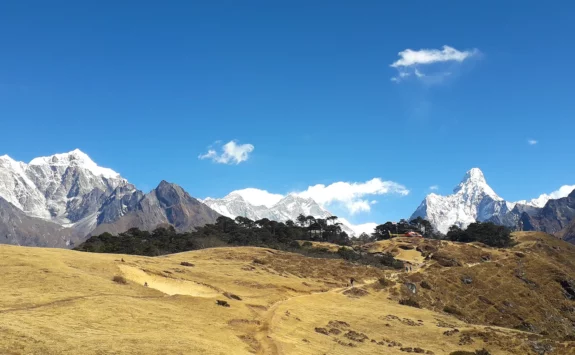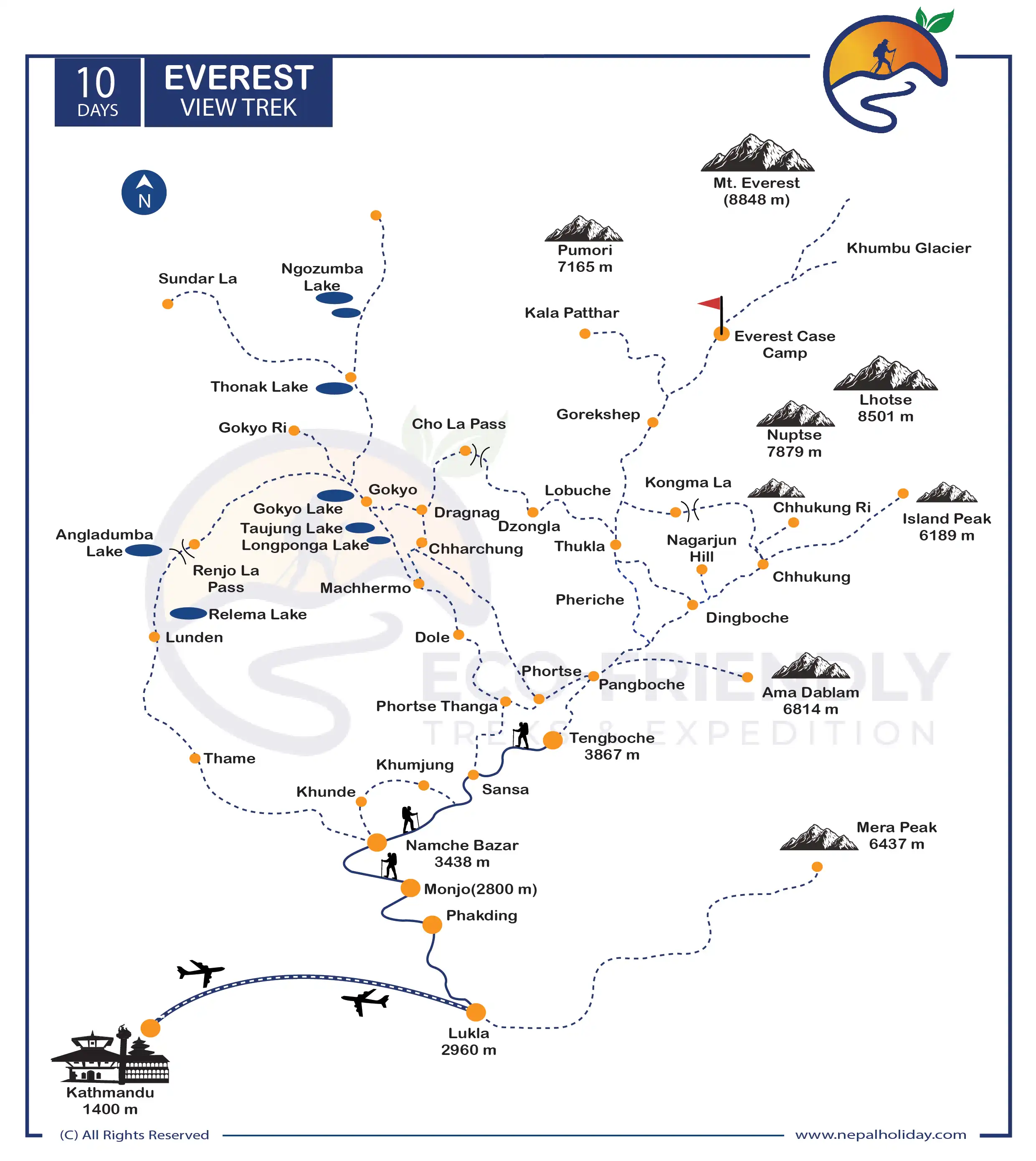Trip Introduction
Overview of Everest View Trek
The Everest View Trek is a short and relatively easy trek in comparison to the Everest Base Camp Trek. The trek is perfect for those who want to observe Mount Everest but do not have the time or physical ability to complete a more challenging trek.
The journey lets you observe the gleaming peak of the world’s highest mountain, Mt. Everest, and other mountain ranges. In this 8-day Everest Panorama Trek itinerary, you will experience short hikes from Lukla to Namche Bazaar and a visit to Tengboche.
Tyangboche monastery is said to be the home of the highest Buddhist monastery in the Khumbu area. It is also thought to be the best place to trek in Nepal to see Everest and its neighboring peaks over 8,000 meters. The trek to Tyangboche monastery is called the “Everest View Trek” because it goes through the Everest region and gives you a great view of Everest and other mountains in the area.
On a short 8-day trek, you can see amazing vistas from Namchebazar; Mt. Everest, Ama Dablam, Lhotse, Kongde Ri, and Kusum Kanguru. A few additional experiences of great sherpa communities in the valleys of Thame, Khunde, and Khumjung, including the colorful town nest shape of Namche bazaar.
The Sagarmatha National Park, the best wild area in Khumbu, is likely to be one of the best parts of the Everest View trekking trip. Here, you can walk through pine and rhododendron forests, cross terraced farms and grasslands, climb ridges with deodar and fir trees, and reach beautiful vantage points from which you can see the whole Himalayas.
Itinerary of Everest View Trek
From Kathmandu, we will catch a flight to Lukla at dawn. Enjoy a breathtaking panorama of the Nepali countryside as you soar above it. Views of breathtaking mountain ranges will set the stage for your adventure. We plan to take it easy after arriving at Lukla. From here, we’ll begin our journey to Phakding. Traveling to Phakding is a scenic experience in and of itself. Our first stop will be in Chheplung, which we will reach by descending the trail. To get to the settlement of Thado Koshi, we must continue on our journey and cross a suspension bridge. After there, we’ll head up a steep path to Ghat. Our last destination for the day is one hour away at Phakding village, located on the bank of the Dudh Koshi River.
Namche Bazaar is our destination for today. We will be crossing the 3,000-meter mark today, so we will get moving after breakfast. From here, we’ll have a gradual ascent to Toktak (at 2,760 meters) and Bentak (at 2,710 meters). On our way to Monjo, we’ll pass through some stunning pine and rhododendron woods near the Dudh Koshi River valley.
Your trekking permit will be examined at the entrance to Sagarmatha National Park in Monjo. We’ll be making our way down the rocky path to Jorsale (at 2830 m) now. After a while on the trail, we’ll reach a steep slope that leads to Namche Bazaar. Namche Bazaar is the most significant destination along the path due to its beauty and significance. Several gift shops in this major transportation hub are sure to pique your interest. Namche Bazaar will be our overnight stop for today.
You have the option to diverge from the primary route today and pay a visit to the towns of Khumjung and Khunde. These settlements are situated at a higher elevation than yesterday’s stopping point.
Today, we’ll make our way back to Tengboche. As we trek toward the Dudh Koshi, we will pass through a number of quaint settlements. Once we reach the bottom of the incline, we’ll turn around and head back up the trail. After that, we’ll continue on our way, and after another two hours of trekking, we’ll arrive at Tengboche. Once we reach Tengboche, we’ll make our way to the monastery there. From this vantage point, we can see numerous mountains, including Everest, Lhotse, Nuptse, Lhotse Shar, Ama Dablam, Thamserku, Kangtega, Kusum Kanguru, and many more.
The initial phase of the day begins with a sharp drop as we continue our walk down a path that runs alongside the Dudh Koshi River and takes us through forests of rhododendrons and fir. After passing via Tashinga and Sansa, we’ll arrive in Kyangjuma in Namche Bazar for some lunch. The summits of Ama-Dablam, Thamserku, Nuptse, Lhotse, and the gigantic Everest will all be visible to us as we go. After 4-5 hours, we will arrive in Kyangjuma.
As we make our way around for the final time, today will be the final day of trekking. When we get to Lukla, we’ll conclude our walk. After leaving Monjo, we’ll find a path that quickly drops down to Chauri Kharka’s airport. Before arriving in Lukla, our final destination, we will pass through the villages of Phakding and Cheplung. Celebrate your accomplishment by making the best possible memories of your farewell night in the Everest region.
On this day, we will take a flight to return to Kathmandu. Take in the magnificent scenery as you fly through the sky for 45 minutes. You will be met at the airport and taken directly to your accommodation in Kathmandu. Tonight is your last night in Kathmandu, so make the most of it and stock up on trinkets to take home.
Includes/Excludes
What's Included?
- KTM-Lukla-KTM domestic flights
- Khumbu Pasang Lhamu Rural Municipality Permit and Sagarmatha National Conservation Area Trekking Permit
- Experienced Himalayan trek guide for 06 days
- One porter for two guests for 06 days (prepare to give max. 15 kgs’ luggage from each of you so that it will not exceed 30 kg. for your porter)
- Basic yet comfortable accommodation for 06 nights on a twin-sharing basis during the trekking as per itinerary
- Staff insurance
- 06 x set breakfast, 06 x set lunch and 06 x set dinner while on the trek
- Purified drinking water during the entire trekking as per itinerary
- General first aid medicine kit
- Complimentary T-shirt
- Duffel bag during the trek
What's Excluded?
- Food and accommodation in Kathmandu.
- Personal expenses of any kind
- Excess baggage costs during your Lukla flight
- Any travel insurance
- Any additional cost due to natural calamities and unforeseen circumstances might affect itineraries.
- Tips for any staff or guide
- Costs associated with evacuations due to illness, accidents, or other natural disasters like earthquakes, landslides, floods, etc.
- Anything that is not listed in the “PRICE INCLUDES” section above.
Special Group Discount Price
| Group Size | Price |
|---|---|
| 1 Person | US$ 1180 Per Person |
| 2 People | US$ 1051 Per Person |
| 3 People | US$ 1018 Per Person |
| 4-6 People | US$ 1007 Per Person |
| 7-9 People | US$ 996 Per Person |
| 10-12 People | US$ 995 Per Person |
| Over 12 People | US$ 986 Per Person |
Essential Information - Everest View Trek
Everest View Trek Route Map
The journey begins with an adventurous flight from Kathmandu to Lukla, then a trek towards Phakding. Along the way, you will follow the Dudh Koshi River, passing through charming Sherpa villages en route to Namche Bazar. Here, you can immerse yourself in the local culture and lifestyle while acclimatizing.
Next, you will travel to the picturesque village of Khumjung, where you can visit the Khumjung Monastery and see the famous Yeti Skull. Afterward, return to Tengboche, where you can explore the Tengboche Monastery, the largest and most important monastery in the region. The journey offers breathtaking views of the Himalayan peaks, including Mount Everest, Lhotse, Nuptse, and Ama Dablam.
The trek then descends towards Namche Bazaar, where you can peruse the local market and purchase mementos before heading back to Lukla.
Everest View Trek Difficulty
The Everest View Trek is a moderate-level trek that requires walking uphill and downhill on rugged terrain, including steep inclines and declines. The trek involves crossing suspension bridges over deep gorges and river valleys.
The trek takes you up to 3,870 meters (12,700 feet) at Tengboche Monastery, and proper acclimatization is crucial to avoid altitude sickness and ensure a safe and enjoyable experience.
Despite the challenges, the Everest View Trek is suitable for beginners with a moderate fitness level and some trekking experience. Prior physical preparation, such as cardiovascular exercises, hiking, and walking, is recommended before embarking on the journey.
Everest View Trek Permit
Before starting the Everest View Trek, it’s crucial to obtain two permits: the Sagarmatha National Park Permit and the Khumbu Pasang Lhamu Rural Municipality Permit.
The Sagarmatha National Park entry fee is mandatory for entering the park, which is a UNESCO World Heritage Site. The permit fee for foreigners is approximately 3,000 NPR, while SAARC nationals are charged 1,500 NPR.
On the other hand, the Khumbu Pasang Lhamu Rural Municipality Permit is required to enter the Khumbu region and costs around USD 20 per person for foreigners. Obtaining these permits is vital to ensuring a safe and enjoyable trekking experience.
Lukla Flight and Weather for the Everest View Trek
Lukla is on top of a mountain and is the gateway to the Everest region, where mountains are present on three sides of it. In the Highlands, you can see better in the early morning. On the other hand, a tailwind builds slowly throughout the afternoon. Because of this, flights to and from Lukla only happen in the morning.
Most of the time, it only takes 30 to 45 minutes to fly from Kathmandu to Lukla. You will see isolated mountain valleys and Nepal’s interconnected mountain ranges with their terraced scenery passing below you.
The seasons and how well you can see have an impact on the weather in Lukla. Clouds of rain are common during the monsoon season, and spring afternoons often have thunderstorms and strong winds. In the winter, it is easier to see in Lukla, but fog in Kathmandu can sometimes stop flights. And if the weather gets bad, Lukla Airport can close in a matter of minutes and stay closed for a long time, even days, which can mess up flights.
Accommodation on the Everest View Trek
With the growth of the trekking industry, there are now enough lodges along the primary trekking routes in the Everest area. All of the tea shops along the trail have good food and places to stay.
Visitors can now stay in their own rooms at many lodges. The basic furniture in rooms for two people to share is familiar. The ‘living room’ is where you eat and relax. At night, a pot-bellied burner is also used to heat it. Many hikers bring books and cell phones with them to keep themselves busy. But you can also use it to meet other hikers in a friendly way.
We provide standard or average lodging and meals to keep the price down. But if you want, we can walk you through the luxury package if that is what
you want. If you have such a request, please let us know when you book.
Food on the Everest View Trek
Many food alternatives are available during your journey to Everest View Trek, from traditional Nepali dal-bhat (rice and lentil soup) to soups, spaghetti, and momos. There, you will have plenty of options, from local to international cuisines. However, we suggest sticking with your diet plan and focusing on nutritious foods.
We design our menu based on what we have learned over the years about what to eat on a trek. We think about your health, hygiene, and a lot of other things when we plan the menu for the walk. So, we suggest you listen to the guide for food ideas.
The tea houses serve three meals per day, all of which are suitable for eating at high altitudes. Energy is provided through liquid and solid foods like grains, cereals, soups, hot drinks, noodles, potatoes, etc.
Eat more foods that are similar to what the locals eat in the Everest region. There is a wide variety of food available for everyone, including those who follow special diets like the vegetarian or vegan diet or who are gluten-intolerant.
Best season for Everest View Trek
Everest View Trek travels via dirt tracks, muddy hills, narrow trails, and high-altitude areas. Here, the weather is significant and plays a vital role. The best Everest View Trek seasons are late September–November and February–May. During these months, the temperatures can reach as low as -6°C, and conditions are generally steady.
The best months to enjoy the Everest View Trek are April and May. If you want to see the Everest View Trek area at its most exciting, sign up for a tour that departs between March and May, which is peak mountaineering season.
Another great time to visit is after the monsoons have passed, from September to December. This is the peak hiking season when the natural beauty of the area is best appreciated.
Peaceful times to go trekking include the winter and monsoon seasons, while the spring and fall are ideal for studying plants. In the winter, when the mountains are blanketed in snow, they stand out more dramatically. Even so, falling snow, avalanches, and other obstacles can block high routes and are difficult to deal with in the winter.
Altitude sickness and acclimatization on the Everest View Trek
High altitude places you at risk for conditions like acute mountain sickness, high-altitude pulmonary edema, and high-altitude cerebral edema. The risks of these forms of altitude sickness, as well as how to identify and respond to those risks, must be comprehended to guarantee safety.
The highest point on the Everest View Trek is 5,364 meters above sea level. Therefore, altitude sickness is common at this elevation. There are ways to lessen the effects of altitude on the Everest View Trek. High-altitude sickness can be avoided by taking it easy on the ascent, getting plenty of sleep, drinking plenty of water, not smoking, and eating enough. Also, prepare your mind to shut out negative ideas and instead soak in the beauty of your surroundings.
A severe headache, loss of appetite, shortness of breath, fatigue, inability to sleep, nausea, vomiting, a racing heart, and severe dehydration are all symptoms of altitude sickness. If you experience any of these while on the Everest View Trek, you should get medical help right away.
Everest View Trek Packing Suggestions
Please properly pack your luggage for the porter (each of you weighs 15kg; for two of you, a porter is arranged). You will leave the rest of your luggage behind at your hotel until the end of this holiday. Below is a loosely advised Everest View Trek packing list that might help you on your trek:
- Appropriate clothing (3 sets)
- Woolen sweater or jacket
- Thermal inner wear
- Wide-brimmed hat
- Woolen cap and scarf
- Thick woolen gloves
- Waterproof gloves
- Sport Sandals
- Woolen socks (2 pairs)
- Waterproof (not water-resistant) shoes with a good tread/grip
- Rain-proof pants and jacket with hood
- A lock for the duffle bag
- Backpack with waterproof cover
- Sleeping bag suitable for temperatures around 0°C (1 – optional)
- Down jacket with hood
- Camera (optional) (video camera is not permitted by authority)
Other essential items:
- Personal clothing
- Toiletries
- Small thermos for hot beverages
- Water bottle (1 liter)
- Sunscreen lotion (50 SPF or more)
- Castor oil (50 ml) to lubricate the nostrils at high altitude
- Ziplock bags for clothing
- Quick-dry Towel (not a regular one)
- Toilet paper
- Wet wipes
- Sunglasses
- Snacks: chocolates, biscuits, nuts, etc.
- Hand sanitizer
- Powerful flashlight or headlamp (with extra batteries)
These are very general suggestions. The specific ones are based on your living spot, and age range, among others.
Medical Kit
Though we arrange basic medical kits for the Everest View Trek, they are very general and may not be adequate based on conditional necessity. Personal medical equipment with electrolyte packs, pain killers, muscle relaxant cream, band-aids, knee caps, medicines for fever, common cold, headache, nausea, vomiting, diarrhea, indigestion, and any other personal medication is necessary from your side.
Best Everest View Trek in Nepal & alternative trek packages
The Everest View Trek is specially designed for travelers who do not have sufficient time to explore the Everest Region for a longer period of time. However, if you have time to add a few more days to your itinerary, Everest Base Camp and Gokyo Valley Trek would be the best alternative package for you.
We also have other Everest alternative trek packages if you are willing to extend your best Everest View Trek holiday. We believe that we all have different choices while traveling, so we are ready to design an alternative package to your taste.
We also have the Everest Three High Passes Trek option if you want to travel in any season except winter. You also have the option to skip the adventurous flight to Lukla and trek from Jiri to EBC.
We also have some luxury lodge trips to EBC, in case you want more facilities in a remote mountain. You can also choose to take a helicopter tour to Everest Base Camp.
Reviews on Everest View Trek
Be first to post a review in this trip.
© Copyright 2024 Eco-friendly Treks. Website Developed by: AVIVA




